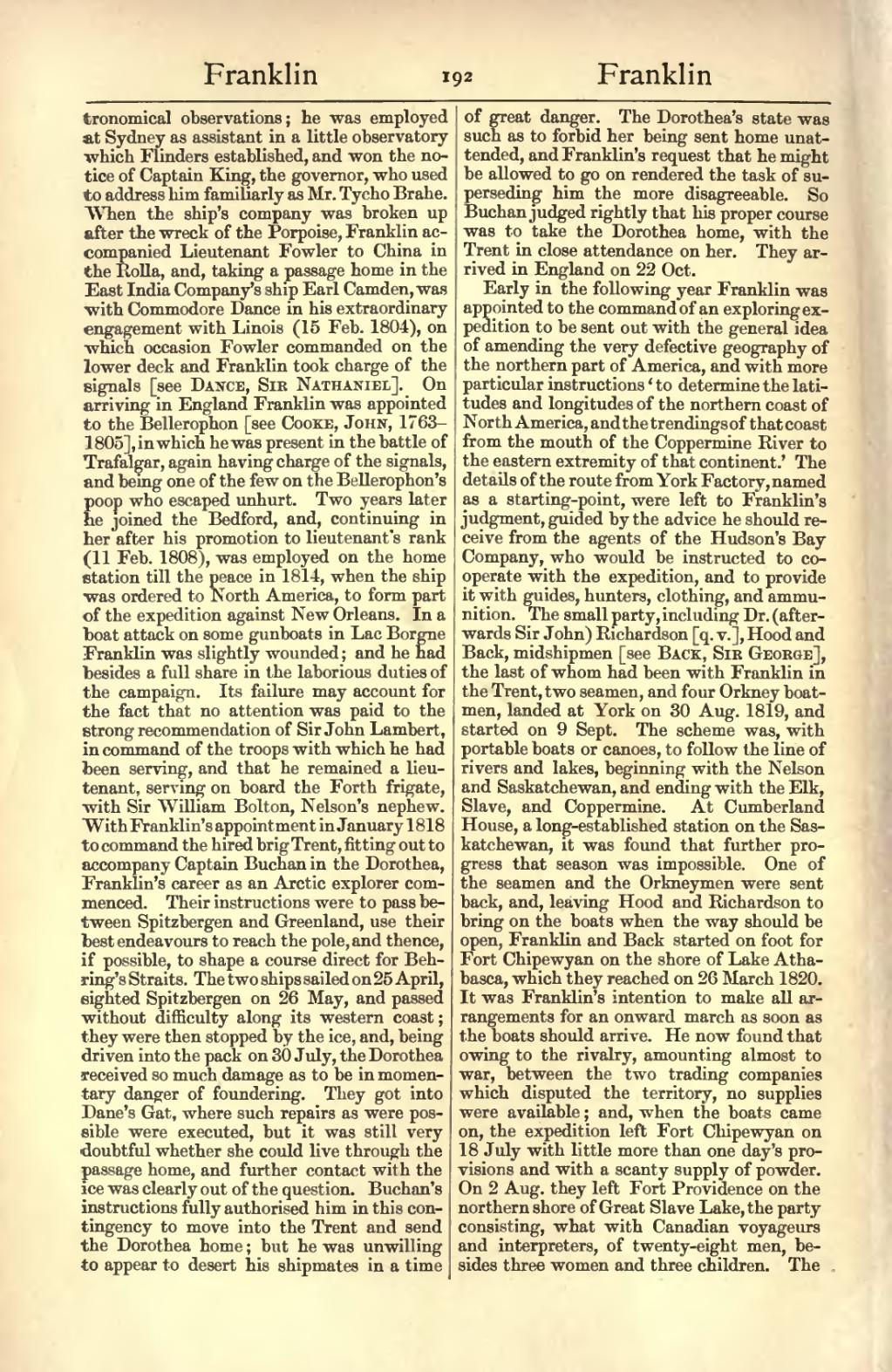tronomical observations; he was employed at Sydney as assistant in a little observatory which Flinders established, and won the notice of Captain King, the governor, who used to address him familiarly as Mr. Tycho Brahe. When the ship's company was broken up after the wreck of the Porpoise, Franklin accompanied Lieutenant Fowler to China in the Rolla, and, taking a passage home in the East India Company's ship Earl Camden, was with Commodore Dance in his extraordinary engagement with Linois (15 Feb. 1804), on which occasion Fowler commanded on the lower deck and Franklin took charge of the signals [see Dance, Sir Nathaniel]. On arriving in England Franklin was appointed to the Bellerophon [see Cooke, John, 1763–1805], in which he was present in the battle of Trafalgar, again having charge of the signals, and being one of the few on the Bellerophon's poop who escaped unhurt. Two years later he joined the Bedford, and, continuing in her after his promotion to lieutenant's rank (11 Feb. 1808), was employed on the home station till the peace in 1814, when the ship was ordered to North America, to form part of the expedition against New Orleans. In a boat attack on some gunboats in Lac Borgne Franklin was slightly wounded; and he had besides a full share in the laborious duties of the campaign. Its failure may account for the fact that no attention was paid to the strong recommendation of Sir John Lambert, in command of the troops with which he had been serving, and that he remained a lieutenant, serving on board the Forth frigate, with Sir William Bolton, Nelson's nephew. With Franklin's appointment in January 1818 to command the hired brig Trent, fitting out to accompany Captain Buchan in the Dorothea, Franklin's career as an Arctic explorer commenced. Their instructions were to pass between Spitzbergen and Greenland, use their best endeavours to reach the pole, and thence, if possible, to shape a course direct for Behring's Straits. The two ships sailed on 25 April, sighted Spitzbergen on 26 May, and passed without difficulty along its western coast; they were then stopped by the ice, and, being driven into the pack on 30 July, the Dorothea received so much damage as to be in momentary danger of foundering. They got into Dane's Gat, where such repairs as were possible were executed, but it was still very doubtful whether she could live through the passage home, and further contact with the ice was clearly out of the question. Buchan's instructions fully authorised him in this contingency to move into the Trent and send the Dorothea home; but he was unwilling to appear to desert his shipmates in a time of great danger. The Dorothea's state was such as to forbid her being sent home unattended, and Franklin's request that he might be allowed to go on rendered the task of superseding him the more disagreeable. So Buchan judged rightly that his proper course was to take the Dorothea home, with the Trent in close attendance on her. They arrived in England on 22 Oct.
Early in the following year Franklin was appointed to the command of an exploring expedition to be sent out with the general idea of amending the very defective geography of the northern part of America, and with more particular instructions ‘to determine the latitudes and longitudes of the northern coast of North America, and the trendings of that coast from the mouth of the Coppermine River to the eastern extremity of that continent.’ The details of the route from York Factory, named as a starting-point, were left to Franklin's judgment, guided by the advice he should receive from the agents of the Hudson's Bay Company, who would be instructed to co-operate with the expedition, and to provide it with guides, hunters, clothing, and ammunition. The small party, including Dr. (afterwards Sir John) Richardson [q. v.], Hood and Back, midshipmen [see Back, Sir George], the last of whom had been with Franklin in the Trent, two seamen, and four Orkney boatmen, landed at York on 30 Aug. 1819, and started on 9 Sept. The scheme was, with portable boats or canoes, to follow the line of rivers and lakes, beginning with the Nelson and Saskatchewan, and ending with the Elk, Slave, and Coppermine. At Cumberland House, a long-established station on the Saskatchewan, it was found that further progress that season was impossible. One of the seamen and the Orkneymen were sent back, and, leaving Hood and Richardson to bring on the boats when the way should be open, Franklin and Back started on foot for Fort Chipewyan on the shore of Lake Athabasca, which they reached on 26 March 1820. It was Franklin's intention to make all arrangements for an onward march as soon as the boats should arrive. He now found that owing to the rivalry, amounting almost to war, between the two trading companies which disputed the territory, no supplies were available; and, when the boats came on, the expedition left Fort Chipewyan on 18 July with little more than one day's provisions and with a scanty supply of powder. On 2 Aug. they left Fort Providence on the northern shore of Great Slave Lake, the party consisting, what with Canadian voyageurs and interpreters, of twenty-eight men, besides three women and three children. The
